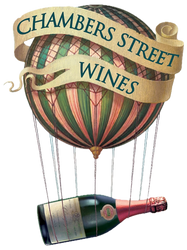Giro d'Italia - A tour of Italy from North to South
5/30/25 -
Over the last month or so, we've had the pleasure of tasting Italian wines that are new to the New York (and US) market, and revisiting bottles that have been staples on the shelves at Chambers Street since the early days (nearly 25 years ago -- can you believe it?). Though our offering today doesn't follow the route of the epic Giro d'Italia bike race, it represents our own version of a tour of Italy, from the steep slopes of Sassella in the north, to the rustic terrain of Abruzzo, all the way down to the majestic vineyards in the shadows of Mount Etna in Sicily (pictured above). All of the wines on offer today represent classic expressions from their respective regions, inviting pairings and dinner planning, while also being immediately enjoyable for casual sipping with snacks, poolside or BBQ-adjacent. Think Italy, but with a focus on a delicious Summertime vibe!

Terraced Vineyards of Terrazzi Alti in Sassella (photo from terrazzialti.com)
Perched up high in the terraces of the Valtellina in Lombardy, Siro Buzzetti, founder of Terrazzi Alti, now joined by his son, Francesco, is crafting wines that have really caught our attention. Valtellina, like other alpine regions, is known to be particularly difficult terrain for winemakers. That never stopped Siro, a proud local, from gradually growing his holdings from 0.1 to 1.5 hectares and producing fantastic, terroir-focused wine. They farm everything organically, but the main focus is Chiavannesca (a.k.a Nebbiolo), and their vines reach up to 600 meters in altitude. The wines feel very true to place in profile; lively acid with a concentrated perfume, and a minerality that distinguishes the region from the likes of Barolo. Harvest is done by hand, grapes ferment with native yeasts, and the wines are neither fined nor filtered. It gives me pleasure to say I think their hard work has paid off, at least for those of us who get to drink the wine! -Nicolas Douglas

Iole Rabasco of Vini Rabasco in the Vines (photo from rabascowinery.com)
Heading south to Abruzzo, Vini Rabasco is an 11-hectare estate in the hills of Pianella, in the coastal province of Pescara. The vines sit around 450 meters, tucked between the Gran Sasso Mountains and the Abruzzo Mountains, not far from the Adriatic Sea. Led by Iole Rabasco, who took over her family winery in the 2000s, they work primarily with Montepulciano and Trebbiano, the native grapes of the region. The vineyards have always been farmed without the use of chemicals, but in 2006 Iole converted to full biodynamic practices with the goal of leaving the land better than she found it. One byproduct of this focus on preserving the land is that they happen to make some incredible wines! All of their grapes are hand-harvested and processed quickly (within one hour) to preserve freshness and reflect the character of the place. They do not do any fining, filtration or additions of sulfur, and wines are aged in either stainless steel tanks or glass demijohns (damigiana in Italian). When tasting the wines recently we were all moved by the incredible freshness and levity they possess, not always a common feature in an area known for more fleshy, powerful wines. Acidity is vibrant and alcohol levels are moderate: the Cancelli Trebbiano sits around 10% abv and the Cancelli Rosso a cool 12.5%, both packing plenty of substance but not weighing you down. The real standouts were the Rosatos, both the Cancelli Rosato raised in steel tanks and the magical Damigiana Rosato, aged in 54-liter demijohns. Falling somewhere between a light red and a dark rosé, these are perfect wines for the summer that can be enjoyed on their own or around the table. They are nuanced and full of character but still clean and endlessly drinkable—the clear glass bottles are a nod to the table wines Iole grew up drinking with her grandfather, which really is the ideal setting for these joyous wines! -Jeff DiLorenzo

The final stop on our tour is on the island of Sicily, more specifically, the famous volcano named Mount Etna. Here, we are focusing on wines from three estates: Massimo Lentsch, Monterosso, and Ciro Biondi. The Massimo Lentsch wines are new to the US and the Etna Bianco and Etna Rosso, from vineyards on the northern slopes of Etna, impressed us with vibrance, trademark minerality, and overall great value for the quality.
Monterosso is a project started by three friends, Giovanni Ferlito, Aurelio Marconi, and Gianluca Strano. The friends, who have about 3 hectares of vines, organically care for old Nerello Mascalese and Carricante vines (averaging 70 years of age) on soils of sand and pumice. Ash from the volcano, with elements such as potassium, phosphorus and manganese, is also intermingled. The vines are trained in an ancient style known as alberello egeo, which means each one is planted alone and supported by a single chestnut post. Their small-production estate is creating wines that represent the world around it. With an eye to tradition, a dedication to organic production, and a determination to display vintage character, these wines have been a natural fit for our Sicilian section at the shop since their first vintage in 2015.

-Eben Lillie
As a quick refresh on the setting, here is some essential information about the Etna DOC from our friends at Azienda Agricola Monterosso: "Mt. Etna, situated in the North-East part of Sicily, is the tallest active volcano in Europe. It reaches the height of 3,329 metres and it has a total vineyard surface area of 3,000 hectares. The Etna DOC vineyards, mainly located between 400 and 1000 meters, are characterized by high temperature variations between the day and the night, which can exceed 30° C during the summer. The characteristic elements that made Etna unique in the past remain unchanged today: small irregular plots, terraces with dry built lava stone walls, elegant mansions and “palmenti”. The viticulture is also distinguished by biodiversity with unique and native grape varieties such as Carricante and Nerello Mascalese." (from monterosso.wine/en/etna)
... And a detailed explanation of the alberello style of vine training in Etna, from the Massimo Lentsch website: "Each vine is an individual: that is how we might summarize what it means to use the alberello training system. Indeed, with this growing method, the plants form part of a whole (i.e. the vineyard) and, as in a little village, each one contributes to the life of all the others. Each one is in symbiosis with the others, and a kind of self-regulation takes place that leads to overall equilibrium. Also, in this way, the vines are forced to go deep down with their roots in order to find all the nutritional substances that will then become part of their patrimony. This aspect provides natural added value for those who want to make high-quality wines. We also like to recall our links with history, which one is aware of in every corner of Sicily. The Ancient Greeks and later the Romans used these kinds of training systems. And still today in the Mediterranean – but also elsewhere – every vine reconnects us with thousands of years of history, a history that is unique compared to that of anywhere else in the world."



